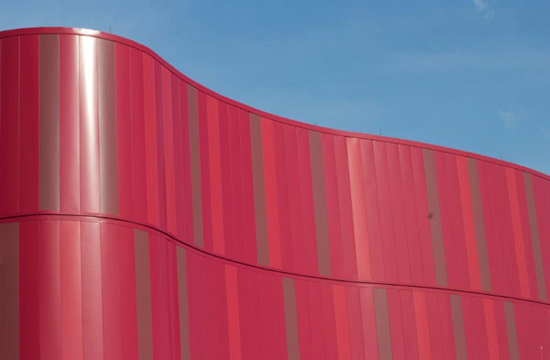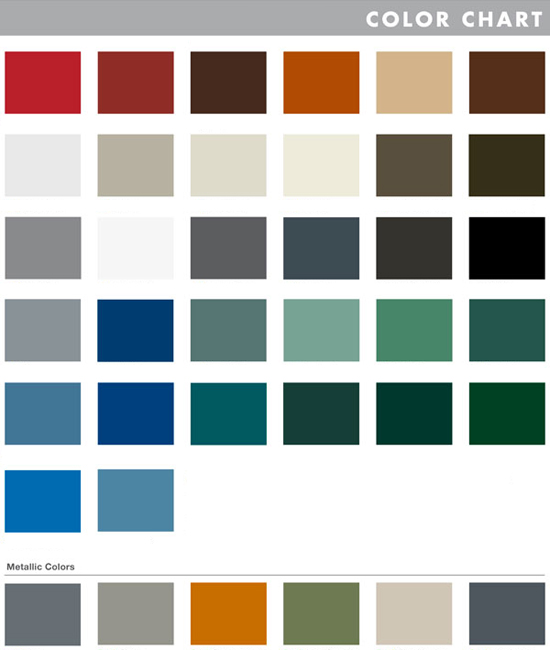Metal Exterior Walls
Specifying Metal Wall Panels
When specifying metal wall panels, there are choices and specification details to pay attention to so that the best products are selected for the building where they will be installed. The Master Format section number commonly used is 07 41 00 for metal roof and wall panels. Some of the relevant items to address in a standard 3-part specification format are highlighted as follows.
Part 1 - General
Quality assurance is often addressed by citing specific national testing and standards for products. In the case of metal wall panels, there are a full range of appropriate tests that have been developed and are accepted by the industry including the following for the basic sheet metal used:
• ASTM A653 Standard Specification for Steel Sheet, Zinc-Coated (Galvanized) or Zinc- Iron Alloy-Coated (Galvannealed) by the Hot-Dip Process
• ASTM A792/A792M Standard Specification for Steel Sheet, 55 % Aluminum-Zinc Alloy- Coated by the Hot-Dip Process
• ASTM B209 Standard Specification for Aluminum and Aluminum-Alloy Sheet and Plate
There are also standards for the performance of wall assemblies that will apply to those that use metal wall panels:
- ASTM E283 Standard Test Method for Determining Rate of Air Leakage Through Exterior Windows, Curtain Walls, and Doors Under Specified Pressure Differences Across the Specimen
- ASTM E331 Standard Test Method for Water Penetration of Exterior Windows, Skylights, Doors, and Curtain Walls by Uniform Static Air Pressure Difference
- ASTM E1592 Standard Test Method for Structural Performance of Sheet Metal Roof and Siding Systems by Uniform Static Air Pressure Difference
When it comes to fire testing of exterior systems, the following may be applicable depending on the wall design:
- UL 263 Fire Tests of Building Construction and Materials
- ASTM E-84 standard for fire testing of materials
Other General specification information includes the appropriate request for submittals that confirm the correct metal wall panels are being ordered and fabricated. Obviously some of this is useful during design while under an integrated project delivery process, the fabricator may be brought in during the design stage. In any case, a full warranty should be called for and submitted that demonstrates coverage for up to 20 years including cracking, peeling and color fade at a minimum.
Part 2 - Products
Identifying the specific metal wall panel products that are desired requires covering several items. If multiple product types are selected for a building, then obviously they each need to be specified and their locations identified on the drawings.
- Panel type and profile: the particular type of panel needs to be selected such as corrugated, flush, or composite (MCM). Within the type(s) selected, then a specific profile needs to be identified to be sure that the desired appearance is achieved.
- Metals: Fundamental to the panel is the choice of metal being used. The choice may be influenced on the difference in environmental impact between say aluminum and steel and the degree to which they contain recycled material. Zinc or copper alloy may also be preferred based on the ability to avoid an additional finish and a potentially much longer service life as a result.
- Attachments: Concealed fastening is most often preferred for aesthetic reasons and will thus dictate specific attachment methods consistent with the panel design and profile. Keep in mind that dissimilar metals should not be used to avoid galvanic corrosion from the interaction of those metals. In cases where exposed fasteners are acceptable, then those should be specified accordingly, usually with self-sealing washers of neoprene or similar materials. In coastal conditions, it is advisable to use stainless steel fasteners with painted steel panels.
- Trim: Flashing and trim may be needed to make the wall panel system complete and weather tight. In that case, it should be fabricated by the manufacturer or a qualified fabricator out of matching material. Aluminum trim may be .032 – .063 gauge or steel can be 24 gauge or 22 gauge as appropriate.
- Finishes: Since all metal wall panels come pre-finished from the manufacturer finish selections need to be clearly and precisely made. The full range available from a particular manufacturer should be identified depending on the type of metal used and whether they are anodized, natural, or painted finishes.


Images courtesy of Petersen Aluminum / PAC-CLAD
A sample of the range of colors available from one manufacturer of prefinished and preformed metal wall panels.
Since some aspects of products vary between manufacturers, using the specification items above will aid in product to product comparisons during design and assure appropriate installations during construction.
Part 3 - Execution
Installing metal wall panels is fairly straight forward but requires appropriate attention to detail to assure the desired outcome is achieved.
- Examination and Preparation: The rest of the exterior wall assembly needs to be in place with the requisite air and water barrier already installed. This should all be inspected for completeness and conformance with the building design before the metal wall panels are installed.
- Installation and Field Quality Control: Since it may be the fabricator that is doing the installation, the qualifications of that fabricator should be known ahead of time. In many cases, the manufacturers have specific instructions or recommendations on how to best install the products they produce so these should be referenced and followed.
- Vinyl masking: In cases where a lot of handling is anticipated, vinyl masking is usually recommended and installed on all fabrications. Manufacturers will suggest that this strippable vinyl film must be removed immediately after installation to avoid marking or undue difficulty in removing it later.
- Cleaning and Protection: The nature of the panel finishes is to be very smooth and easy to clean. In most cases, dust and dirt from construction can be easily wiped clean with a soft cloth or rinsed with water. If needed, a common soap and water rinse can be used to clean the panels.









